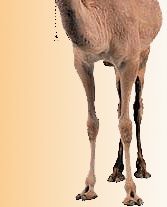Rajasthan is the home of the tigers, black bucks, chinkara, the rare desert fox, the endangered caracal, the great Indian bustard, gavial, monitor lizard, wild boars, porcupine. Migratory birds like the common crane, ducks, coots, pelicans and the rare Siberian cranes, imperial sand grouse, falcons, buzzards flocks to this state during the winter months. Typical areas representing each of the ecosystems have been earmarked as special areas wildlife. Rajasthan boasts of two National Parks, over a dozen Sanctuaries and two Closed Areas. Most of these areas are open to visitors round the year but are closed briefly during the monsoon.
Ranthambore Wildlife Sanctuary
Tiger, Ranthambhore TravelsRanthambhore, in the state of Rajasthan, is one of the smallest Project Tiger reserves. It's name comes from the vast fort that stands in the middle of the forest. The name Ranthambore is derived from two hills in the area, Ran and Thanbhor. Another version says that Ranthambhore was once called Rana Stambhapura or City of the Pillars of War!
The Ranthambhore National Park at the junction of the Aravalis and the Vindhayas is a unique juxtaposition of the natural and historical richness, standing out conspicuously in the vast, arid and denuded tract of eastern Rajasthan, barely 14 kms. from Sawai Madhopur. The elegant Ranthambhore fort called the Jogi Mahal is now the forest rest house.
It spreads over a highly undulating topography varying from the gentle to the steep slopes; from flat topped hills of the Vindhayas to the conical hillocks and the sharp ridges of the Aravalis. An important geological feature the 'Great Boundary Fault' where the Vindhaya plateaus meet the Aravali hill ranges, meanders through the reserve. The National Park is bounded by the rivers Chambal in the South and the Banas in the North. Pure stands of the Dhok interspersed with open grasslands of the plateaus, six large lakes - Gilai Sagar, Mansarovar, Malik talao, Raj Bagh and Padam Talao with in the National Park.
Sariska Wildlife Sanctuary
Tiger, Sariska Travel VacationsThis park is situated only 200 km from Delhi and 107 kms from Jaipur. Although larger than Ranthambor, it is less commercialised and has less tigers but a similar topography. It covers an area of 800 sq km in total, with a core area of approximately 500 sq km. The Northern Aravali Hills dominate the skyline with their mixture of sharp cliffs and long narrow valleys. The area was declared a sanctuary in 1955 and became a National Park in 1979.
The landscape of Sariska comprises of hills and narrow valleys of the Aravali hill range. The topography of Sariska supports scrub-thorn arid forests, dry deciduous forests, rocks and grasses. The broad range of wildlife here is a wonderful example of ecological adoption and tolerance, for the climate here is variable as well as erratic.
It is located in the contemporary Alwar district and is the legacy of the Maharajas of Alwar. Pavilions and Temples within Sariska are ruins that hint at past riches and glory. The nearby Kankwadi Fort has a long and turbulent history.
In morning and evening, wildlife in Sariska heads towards the many water holes, which litter the park, thus providing the guests with their best chance of viewing game. At some of these watering holes it is possible to book hides which are situated in prime spots for wildlife viewing.
The picturesque Siliserh Lake lies along the edge of the Sariska Tiger Reserve and a charming hunting lodge overlooking it, is a marvelous place for visitors to stay.
Darrah Sanctuary
Leopard, Darrah:
An erstwhile royal hunting preserve of the Maharaja of Kota, it is a thickly forested sanctuary lying along the southeastern border of Kota. This hilly sanctuary with thick forests is worth a visit.
The animals here include Wolf, Sloth Bear, Chinkara and Leopard. This sanctuary is stretched in the area of 250 sq Kms, almost 50 Kms from Kota. The best time to visit is between February and May.
Desert National Sanctuary
Black Buck, Rajasthan Holiday VacationsThe Desert National Park is an excellent example of the ecosystem of the Thar Desert and its rich fauna. The Sudashri forest post is the most ideal place for observing wildlife in the Desert National Park. Sand dunes form less than 20 percent of the Park, which consists of craggy rocks, pavements and compact salt lake bottoms, intermedial areas and fixed dunes.
Its inhabitants include the blackbuck, chinkara, wolf, Indian fox, desert fox, hare and desert cat. Flights of sandfrouse start coming to waterholes from sunrise onwards. One also hear the morning call of the grey partridge. Blue tailed and green bee-eaters, drongos, common and bush quail and Indian rollers are birds, which are commonly found around waterholes. the park is also home to the great Indian Bustard which is peril of extinction.
Jaisamand Wildlife Sanctuary
Jaisamand Sanctuary is situated 50 kms south of Udaipur the picturesque city of lakes verdant valleys and hills. It is on the bank of Jaisamand Lake, the second largest artificial Lake in Asia. The sanctuary extends over an area of 52 sq kms of thick forests land.
The leopard, hyena, jungle cat, fox and wolf are among the carnivores of the sanctuary. Other wildlife here includes sambar, chital, langur and chinkara. The Jaisamand lake is the abode of crocodiles, turtles and a variety of fish. Various species of terrestrial and water-birds can also be seen here .
Keoladeo National Park
The marshes of Keoladeo, more popularly known as Bharatpur, was the private hunting reserve of the Maharajas of Bharatpur. It was developed in the late 19th century by creating small dams and bunds in an area of natural depression to collect rainwater and by feeding it with an irrigation canal. Over the years, the lakes attracted great numbers of waterfowl and the Maharajas held grand shoots with family, friends and visiting dignitaries. Two-thirds of the park lies under water, the extent and volume depending on the intensity of the rains. The remaining one-third of the park is covered in dry deciduous forests (with Acacia, Ber, Kadam and Khajur trees) and extensive grasslands. On the raised ground outlining the wetlands grow a profusion of Acacia trees, where the resident water birds nest, often in large mixed colonies, a spectacular sight during the monsoon.
Keoladeo is famous as one of Asia’s finest birding areas, with over 380 resident and migrant species, including the Common, Demoiselle and the rare Siberian Cranes. It is also an excellent place to watch mammals like Golden Jackal, Striped Hyaena, Fishing Cat, Jungle Cat, Nilgai, Sambar, Blackbuck and wild Boar. The park derives its name from the temple of Keoladeo (Shiva) and ‘ghana’ which locally means dense, implying the nature of the vegetation. During the cool winter months it is also possible to see large Indian Pythons sunning themselves.
Kumbhalgarh Sanctuary
White Breasted Kingfisher, Rajasthan Travel VacationsIs located in the most rugged of the Aravali in Pali, Rajsamand and Udaipur districts of Rajasthan. It takes name after the impressive historic fort of Kumbhalgarh, which come into view over the Park. It is 578 sq Kms in area and at an altitude of 500 to 1,300m.
It is home to a very large variety of wild life, some of which are highly endangered species. The wild life includes wolf, leopards, sloth bear, hyena, jackal, jungle cat, smabhar, nilgai, chaisingh (the four horned antelope), chinkara and hare.
The bird life at Kumbhalgarh is also gratifying. The normally shy and untrusted grey jungle fowl can be spotted here. Peacocks and Doves can be sighted regularly feeding on grains scattered by the jungle guards. Bird like the red spur owls, Parakeets, golden Oriole, grey Pigeons, Bulbul, Dove and white breasted kingfisher can also be seen near the water holes.
Kumbhalgarh’s natural beauty is attracting many tourists and especially for its accessibility from Udaipur, which is 100 Kms from here. Foot tracking and horse safari organised by local tour operators are proving to be very popular. A typical safari route enters the sanctuary from the Kumbhalgarh Fort and cutting across the sanctuary it reaches Ghanerao, and then borders an old abandoned road. On this road, one can sight Chinkaras, Neelgais, four horned Antelope and many birds.
Mount Abu Sanctuary
Langoor, Rajasthan Travel PackagesThe sanctuary comprises the oldest mountain ranges - The Aravali. It was declared as a Wildlife Sanctuary in 1960. Apart from having several sightseeing places this sanctuary is a draw for nature lovers as it has great potential for Eco-tourism, In shape this sanctuary is long and narrow but the top spreads out into a picturesque plateau which is about 19 km. is length and 5-8 km. in breadth.
Attitudinally it varies from 300m. at the foot Mil to 1722m. at Gurashikhar, the highest peak of the Aravali Ranges. The rocks are igneous and due the weathering effect of wind and water, large cavities are common the rocks. This feature is typical of Aravali and particularly of Mt. Abu. Toad Rock in Mount Abu is one such example.
Mount Abu has a very rich floral biodiversity starting with xenomorphic subtropical thorn forest at the foot hills to subtropical evergreen forest along water courses and valleys at higher altitudes. These forests consist of 112 plant families with 449 genera and 820 species.
Of these, 663 species are dicots while 157 species are monocots. Mount Abu is the only place in Rajasthan where one can observe a variety of orchids. The place is also rich in bryophytes and algae. Three species of wild roses and 16 species of feras some of which are quite rare have also been reported from here. The South- West part of the Sanctuary is rich in bamboo forests.
Jungle Cat, Rajasthan Tours & Travels
The sanctuary is rich in herbal medicinal plants also. About 81 species of tree, 89 species of shrubs, 28 species of climbers and 17 species of tuberous plants of medicinal importance have been identified.
A variety of fauna Including highly rare, threatened and endangered species are found in this sanctuary. The past history of Mount Abu indicates the presence of Lion (last recorded in 1872) and Tiger (last reported in 1970). Presently the Panther is the apex predator.
Other animals found here are Sambhar, Jungle Cat, Small Indian Civet, Wolf, Hyaena, Jackal, Indian Fox, Common Langoor, Wild Boar, Pangolin, Rate!, Common Mongoose, Indian Hare, Porcupine, Hedgehog, etc. The sanctuary provides an ideal habitat for Sloth Bear, The population of Sloth Bear is increasing regularly as it can be seen while going through the forests or motoring on the road.




